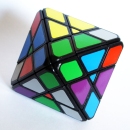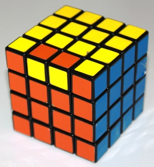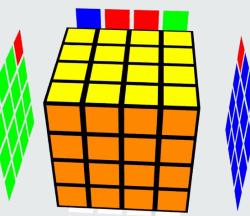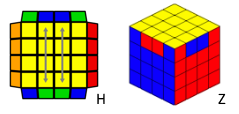4x4x4 Rubik’s Cube – Rubik’s Revenge

A scrambled Eastsheen 4x4x4 cube
The Rubik’s Revenge is the 4x4x4 version of the Rubik’s Cube. This is also a Hungarian invention, designed by Sebestény Péter. The interesting about thistwisty puzzle is that can be used as a 2x2x2 if we don’t rotate the outer layers and like a 3x3x3 if we rotate only the outer layers. There are about 7.4×1045 possible permutations for this puzzle, which is quite a huge number.
It has 24 edges, 24 centres and 8 corner fields. From the inside it’s is similar to a Rubik’s Cube but in this case the 4 centre pieces are held together. To take it apart pop out a centre piece with a screwdriver. I don’t recommend taking apart the whole cube because reassembling can be hard unless you have four spare hands.
Variations

A shape mod: Octahedron
Maybe the most common 4x4x4 mod is the Octahedron, but there is a pillowed version, the Mirror 4x4x4 and 4x4x5 cube based on a similar mechanism. In some cases they fuse together some pieces changing the solution method. The 4x4x4 Circle Magic has a circle in the centre making it more tricky. An easier version is the Super Mask Magic where you don’t have to orient the edge pieces and the centres are all the same.
The solution
| 1 | 2 | 3 | 4 |
| 5 | 6 | 7 | 8 |
| 9 | 10 | 11 | 12 |
| 13 | 14 | 15 | 16 |
Pair the edges and centres,
then solve like a Rubik’s Cube
then solve like a Rubik’s Cube
The solution is a little bit more complicated than the classic Magic Cube’s method, but if you know how to solve a 3x3x3 then you will learn fast how to fix the Rubik’s Revenge. I assume that at this point you are familiar with the notation of the Rubik’s Cube. We are going to mark the double layer turns with lower case letters. The 4x4x4 cube is an even order puzzle and it doesn’t have a fixed centre piece which determines the colour of a face. If you’re not familiar with the colour scheme of the cube first you have to find which colour goes where by checking the corner pieces. According to this you have to make the 2×2 centres and after that pair the corresponding edge pieces. When this is done correctly the puzzle can be solved like a 3x3x3 Rubik’s Cube. For the sake of this tutorial let’s mark the pieces of a field with numbers from 1 to 16.
1. Solve the centres
Let’s begin the solution with the white 2×2 centre (marked with 6-7-10-11). This can’t be such a big challenge. After that do the opposite 2×2 centre (usually yellow, but you can check the corner colours to make sure). The algorithm to move pieces from the front face to the top while the white face remains intact at the bottom: r U2 r’, r U r’ or r U’ r’ (r means you have to rotate the two right layers together). This will bring F7 F11 pair to the U10 U6 positions. In the last step you can place the yellow pieces in F7 F11 U7 U11 positions and do a r U2 r’.
When white and yellow centres are done check the corner pieces to figure out the locations of the other four centres related to each other. Hold the cube in your hands with the white and yellow centres facing right and left. Do the next 4 centres one-by-one using the previous algorithms not messing up the already solved pieces. When the step is complete double check that the centres are on the right place.
2. Pair the corresponding edge pieces
| O | O | ||
| X | X | ||
Parallel: F9 – F12
d R F` U R` F d`
d R F` U R` F d`
| X | |||
| X | |||
Cross: F8 – F9
u L` U` L u`
u L` U` L u`
Using the u L` U` L u` (and it’s symmetric: u’ R U R’ u) algorithm get every edge piece next to its pair. Before using this algorithm make sure there are no paired edges on the left-top edge of the cube, because these will be messed up (also check the right-top before applying the symmetric algorithm). You can use the d R F` U R` F d` algorithm if the corresponding edges are facing each other. This algorithm is not messing up other pieces.
3. Solve the Cube like a 3x3x3
The puzzle now can be seen as a scrambled 3x3x3 Rubik’s Cube, solve it like that. If you don’t know how to do that find thebeginner’s method here or use the online Rubik’s solver to finish the solution of the 4x4x4 cube.
4. Solve parities
| 1 | 2 | 3 | 4 |
| 5 | 6 | 7 | 8 |
| 9 | 10 | 11 | 12 |
| 13 | 14 | 15 | 16 |
The top of the cube (front down)
Usually you will be facing a parity. Some pieces are switched or oriented in the wrong way. We have long algorithms to fix these issues.
Notation:
F = outer front face
f = 2 front layers together
2F = inner front layer
These by themselves mean a clockwise rotation, half turn if followed by 2 and counterclockwise rotation if followed by an apostrophe.
F = outer front face
f = 2 front layers together
2F = inner front layer
These by themselves mean a clockwise rotation, half turn if followed by 2 and counterclockwise rotation if followed by an apostrophe.
To switch U1 and U16 do the algorithm:
r2 2F2 U2 f2 – D r2 U2 f2 – U’ f2 L2 U2 – B2 l2 U
r2 2F2 U2 f2 – D r2 U2 f2 – U’ f2 L2 U2 – B2 l2 U
To swap U13 and U16:
R U’ R B2 – L’ D L B2 R2 – U 2R2 F2 2R2 – f2 2R2 2F2
R U’ R B2 – L’ D L B2 R2 – U 2R2 F2 2R2 – f2 2R2 2F2
Reorient 14 and 15:
r2 B2 U2 l – U2 r’ U2 r – U2 F2 r F2 – l’ B2 r2
r2 B2 U2 l – U2 r’ U2 r – U2 F2 r F2 – l’ B2 r2
Parity on the 4×4 Rubik’s Cube
Parity is something that most puzzle solvers despise. Extra algorithms that you have to learn in order to solve the cube 100% of the time. It is something that can slow speedsolvers down immensely in official solves, and is generally seen as a pain to deal with. Today I’m going to take a look at parity in all its forms and see why it happens and the reasons why it’s impossible to prevent completely.
Where Parity Occurs and how to solve it.
| a | a | ||
| b | b | ||
Edge parity
One type of pseudo-parity is edge parity. For even layered cubes, this isn’t technically a parity at all, but it still requires an extra “algorithm” to solve, even though it is very short and just involves using the same moves you do to solve the rest of the edges, but in a different order.
It happens when all but two edges are solved. These two edges look the same, but inverted. In the picture, the blue-red edge on the left needs to be paired with the red-blue edge on the right, and the same for the blue-orange edges.
If you know how to solve a 4×4, you will know the flipping algorithm. This is used to flip an edge during edge solving (this algorithm can’t be used for OLL parity because it affects other parts of the cube that aren’t necessary to preserve during edge pairing such as corner orientation and the positions of the edges on top. The flipping algorithm is as follows – R U R’ F R’ F’ R. If you do this to a solved cube, you can see how the algorithm affects the rest of the puzzle, but this is not noticeable during edge pairing.
Now solving this parity should be simple. If you think about what the algorithm is doing, it’s actually quite simple – Uw’ R U R’ F R’ F’ R Uw.
All this algorithm does is slice along so that the other red-blue piece is above the orange-blue piece, flips the edge, then slices back, solving both edges.
The main types of Parity are OLL and PLL Parity for NxN twisty puzzles. It is important to note that these parities can ONLY occur on even layered cubes (4×4, 6×6 etc.) and never on odd layered cubes (3×3, 5×5 etc.). This will be explained later.
OLL Parity
 OLL Parity is a speedsolver’s worst nightmare. PLL Parity can also be a pain, but nothing in comparison to OLL parity. This image shows OLL parity in its purest form, but any state where there is an odd number of yellow edges facing upwards is the same. This is the indication that you have parity. It is called so because it is first noticed during the OLL stage of a solve.
OLL Parity is a speedsolver’s worst nightmare. PLL Parity can also be a pain, but nothing in comparison to OLL parity. This image shows OLL parity in its purest form, but any state where there is an odd number of yellow edges facing upwards is the same. This is the indication that you have parity. It is called so because it is first noticed during the OLL stage of a solve.
It is caused when solving the edges. You see, on a 3×3 puzzle each of the edges are basically “made” for you. They can’t be split in two, therefore they can’t be “flipped”. However, when solving edges on a 4×4, you have no way of knowing whether an edge is “solved” or “flipped”. This means when you have reduced the cube to a 3×3 with the reduction method, although it may just look like a scrambled 3×3, picture it as a scrambled 3×3 after one edge has been removed and put back in the wrong way around.
Because there is no way of telling which way round an edge should go, it’s really a 50-50 chance as to whether or not the number of “flipped” edges you will end up with after edge solving is odd or even. An even number of flipped edges means there is no OLL parity. If you want to see for yourself, take out two edges from a 3×3 and put them back in their places but flipped. Now scramble the cube, and you’ll find that you can solve it. An odd number of flipped edges means that there is OLL parity. Do the same thing: take a 3×3 cube and this time flip three edges in their places. No matter what you do, there will always be one flipped edge remaining when you try to solve it.
This is combined with the fact that you have to solve the centres, meaning they can all be in different places. When solving the first two centres, you can solve them on any side, as long as they are opposite one another. Therefore there is absolutely no way of telling whether an edge is solved correctly or not, meaning OLL parity is completely random.
There are many algorithms that are all unique apart from one thing – They are all very long and difficult to memorise. Many speedcubers try a few different algorithms before they find one they’re able to solve decently fast. However, many speedcubers also use muscle memory for most of the algorithm memorisation, meaning they won’t be able to perform the same algorithm slowly without making a mistake. Even with the best memory and the best algorithm, most speedcubers will struggle to solve OLL parity in under 3-4 seconds, meaning that it can be the cause of a ruined average. OLL parity is also known for the large risk of pieces popping from the puzzle during execution. Because it involves almost exclusively slice turns (turns that would be impossible on a 3×3) and is executed as fast as possible, a pop during this stage can be much larger than a normal pop, and combined with the strong reliance on muscle memory that most speedcubers have, this can prevent the solver from completing the rest of the algorithm without error when the cube is put back together.
PLL Parity
PLL Parity is like the final nail in the coffin for a speedcuber who has already had to deal with OLL parity. Although it is much easier to execute and the algorithms are easier to remember, the time it takes to execute combined with the time of OLL parity can add 6-7 seconds total to an average speedcuber’s solve time.
These images show PLL parity in their pure forms. However, most speedcubers solve PLL parity as soon as they recognise it, which is when OLL has been completed and any OLL parity has been dealt with. The best way to spot PLL parity is when you see a PLL case that is impossible to get on a 3×3 cube. One of the best examples for this is the pseudo-T permutation. After finishing OLL, you will notice the two bars that indicate a T permutation. But instead of having headlights on the side that the bars point towards, you will have a solved bar.

The main algorithm people learn for PLL parity swaps the two edges shown in the first picture. This is called the Half-H perm case. The other case is the Half-Z perm case, and the same algorithm is used but with a setup beforehand. The setup moves the edge on the right so that it is opposite the edge on the front, by doing R2 D’ and then rotating so that the F face is now the U face, then performing the same algorithm.

It occurs for a similar reason to OLL parity. During edge pairing it is impossible to tell whether edges are swapped, therefore having two swapped edges results in some form of PLL parity.
These parities can happen on any even NxN layered cube. For a 4×4 there are two edges that need pairing, but with a 6×6 there are 4. Parities occur, but they are exactly the same as 4×4 parity, they just look bigger.
I won’t provide specific algorithms for OLL and PLL parity here because there are so many that are widely used. If you want to find a list of these, check out this page for a full list of all 4×4 Parity algorithms.
Post a Comment for "4x4x4 Rubik’s Cube – Rubik’s Revenge"